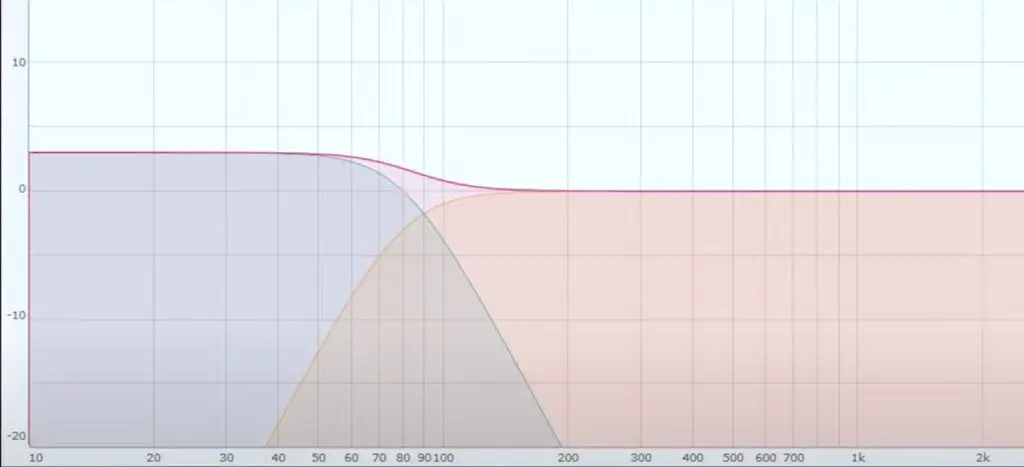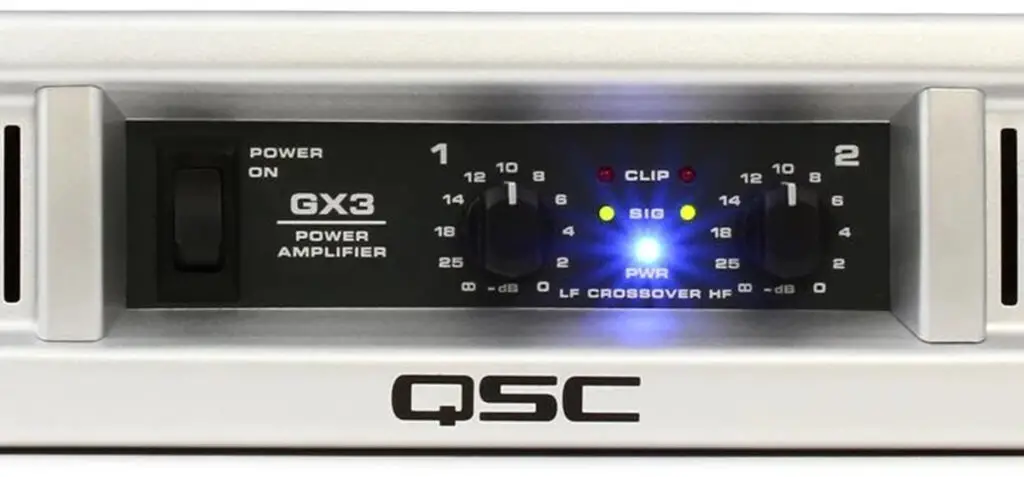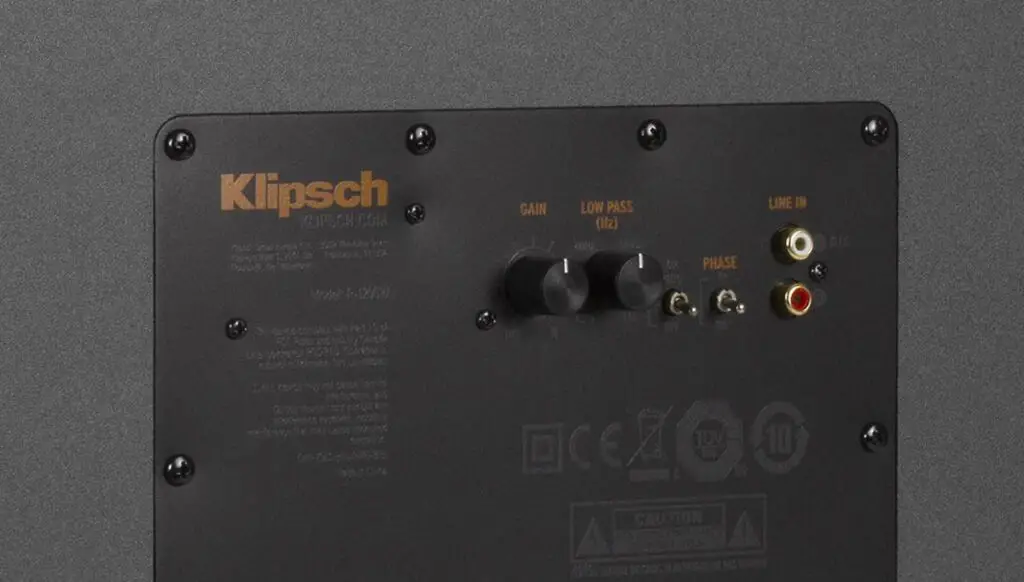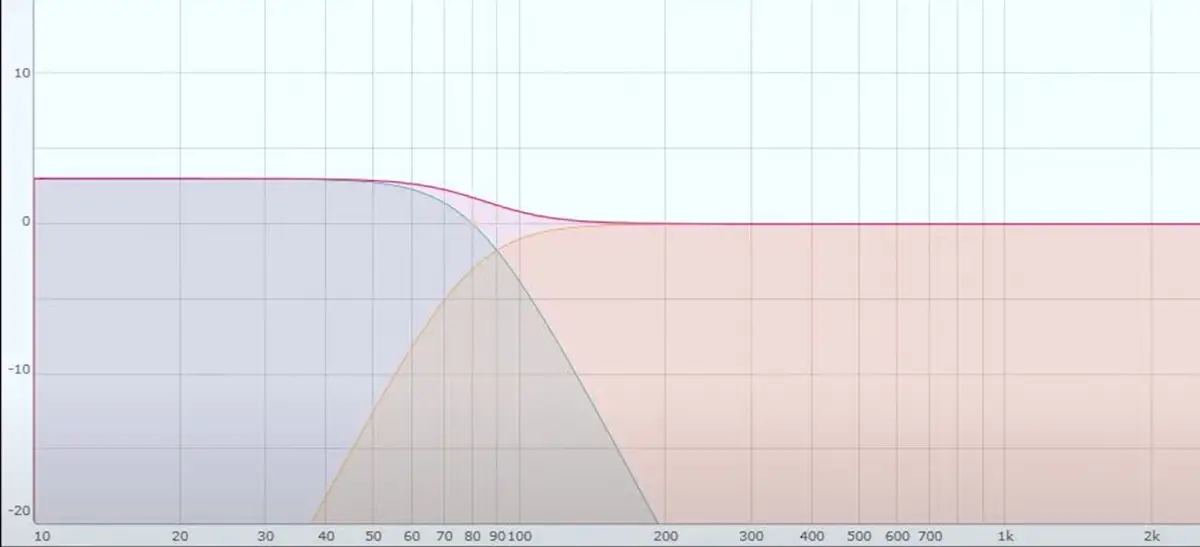In the world of audio, achieving the perfect harmony between various components is key to creating a superior listening experience. One critical aspect of this balance lies in the concept of ‘crossover frequency.’
But what exactly is crossover frequency, and why is it so important for your audio system?
Crossover frequency is a specific point in the frequency spectrum at which an audio signal is divided between two speakers in a multi-speaker audio system. It marks the boundary at which one speaker stops reproducing sound and another one starts, ensuring each speaker operates within its optimal frequency range.
This article will discuss the fundamentals of crossover frequency, explaining what it is, how it works, and its role in enhancing the performance of your speakers and subwoofers.

What Is Crossover Frequency?
The crossover frequency is a specific frequency at which an audio signal is divided between two speakers in a multi-speaker audio system. It’s the point at which one speaker stops playing, and another one starts.
In a passive speaker, the electronic crossover components determine where the sound transitions from the speaker channels to a subwoofer. A crossover frequency is commonly measured in hertz (Hz).
In a typical audio system, different types of speakers are designed to handle different ranges of frequencies.
For instance, tweeters are designed to handle high frequencies, mid-range speakers handle middle frequencies, and woofers (including subwoofers) handle low frequencies.
The crossover is a device that splits the audio signal into these different frequency ranges and sends each range to the appropriate speaker.
The crossover frequency is the dividing line between these ranges. For example, in a system with a tweeter and a mid-range speaker, the crossover frequency might be set at 2000 Hz. Frequencies above 2000 Hz would be sent to the tweeter, and frequencies below 2000 Hz would be sent to the mid-range speaker.
SoundOnSound has an example to look at as well.
In a subwoofer setup, the crossover frequency is typically set somewhere between 80 Hz and 120 Hz. Frequencies below this range are sent to the subwoofer, and frequencies above this range are sent to the other speakers. Lower frequencies are less directional and harder for the human ear to localize, making them well-suited to a subwoofer.
There are two types of crossovers: passive and active. A passive crossover is a physical device that is built into the speaker. An active crossover is a separate device that is connected to the speakers. Active crossovers are typically more expensive than passive crossovers, but they offer more flexibility in terms of the crossover frequency and the slope of the crossover curve.
In an adjustable crossover, the user can change the crossover frequency to best match the capabilities of their specific speakers and their personal preferences.
What Crossover Frequency Should I Use?
Choosing the right crossover frequency depends on several factors:
- The specifications of your speakers and subwoofer: Check the frequency response range of your speakers and subwoofer. The crossover frequency should be set within the range that both your speakers and subwoofer can handle. If the manufacturer provides a recommended crossover frequency, that’s usually a good place to start.
- Room acoustics: The size, shape, and furnishings of your room can affect how sound waves propagate and therefore impact the ideal crossover frequency. If you are listening to music in a small room, then you may want to set the crossover frequency lower to ensure that the bass frequencies are audible.
- Personal preference: What sounds best to you is also an important factor. Some people prefer a higher crossover frequency because it can make the bass sound more prominent, while others prefer a lower crossover frequency to ensure that the subwoofer only handles the very lowest frequencies.
The THX standard recommends a crossover frequency of 80 Hz for home theater systems. This is a common choice because it is within the frequency range that most subwoofers and main speakers can handle and because frequencies below 80 Hz are difficult for the human ear to localize, making them well-suited for a subwoofer.
It’s worth experimenting with different crossover frequencies to see what sounds best in your specific situation. If your system allows, try starting at 80 Hz and then adjust up or down from there until you find the sound that you like best.
If you are using small speakers with small woofers, then you may want to set the crossover frequency lower, such as 60 Hz. This will help to ensure that the bass frequencies are audible.
If you are listening to music in a small room, then you may also want to set the crossover frequency lower. This will help to prevent the bass frequencies from becoming too overwhelming.
If you prefer a more pronounced bass response, then you may want to set the crossover frequency higher. This will allow the woofers to play the bass frequencies more effectively.

How To Set Crossover Frequency For Speakers
Setting the crossover frequency for your speakers involves a few steps, and the exact process will vary depending on your audio equipment. Here is a general guideline:
- Check the specifications of your speakers: You need to know the frequency response of your speakers. This information should be in the user manual or on the manufacturer’s website. Look for the frequency range that your speakers are designed to handle.
- Check the specifications of your subwoofer: Do the same for your subwoofer. You need to know the frequency range that it is designed to handle.
- Determine a suitable crossover point: A good starting point is the -3dB point of your speakers or subwoofer, whichever is higher. This is the frequency at which the speaker or subwoofer’s response has dropped by 3dB, which is generally considered to be the limit of its effective range. Alternatively, you can use the THX recommended 80Hz if your speakers can handle it.
- Adjust the crossover on your receiver or amplifier: Many receivers and amplifiers have a menu system that you can use to set the crossover frequency. The exact process will depend on your specific equipment, so you may need to refer to the user manual.
- Listen and adjust: Play some music or a movie that you are familiar with and listen to the sound. If it seems like the bass is too heavy or too light, or if the transition between the speakers and the subwoofer is not smooth, you may need to adjust the crossover frequency. This step can involve some trial and error to find the setting that sounds best to you.
The goal of setting the crossover frequency is to ensure a smooth transition between your speakers and subwoofer so that all frequencies are accurately represented.
In addition to your amp or receiver, some speakers have built-in crossovers, usually more common in subwoofers.
Here are some additional tips for setting crossover frequency:
- Use a frequency response chart: The frequency response chart for your speakers will show you the frequencies that the speakers are best suited for. This can help you to determine a good starting point for the crossover frequency.
- Listen to your speakers in different environments: The crossover frequency that sounds good in one environment may not sound good in another environment. It is good to listen to your speakers in different environments to get a good idea of what crossover frequency sounds best.
- Be patient: It may take some time to find the perfect crossover frequency. Be patient and experiment with different settings until you find what sounds best to you.
What Is a Subwoofer Crossover?
A subwoofer crossover is a type of electronic filter in an audio system that routes audio signals at specific frequencies to the subwoofer. It is used to ensure that the subwoofer only plays frequencies that it is designed for, typically the lower range of frequencies in the audio signal.
Here’s a bit more detail about how it works:
A crossover is used to split the audio signal into different frequency bands and direct each band to the speaker that can handle it best. This helps to ensure that each speaker only plays the frequencies it is designed for, which can improve the overall sound quality of the system.
In the case of a subwoofer, the crossover filters out all frequencies above a certain point (the crossover frequency) and sends only the lower frequencies to the subwoofer. This frequency is often somewhere between 80 and 120 Hz, but it can vary depending on the specific equipment and preferences of the user.
The slope of the crossover curve determines how quickly the high frequencies are rolled off. A steeper slope will result in a more abrupt transition between the subwoofer and the main speakers, while a shallower slope will result in a more gradual transition.
The crossover frequency and slope of the crossover curve are important factors to consider when setting up a subwoofer. The crossover frequency should be set so that the subwoofer is playing the frequencies that it is best suited for. The slope of the crossover curve should be set so that the transition between the subwoofer and the main speakers is smooth and seamless.
There are two types of subwoofer crossovers: passive and active. A passive crossover is a physical device that is built into the subwoofer.
An active crossover is a separate device that is connected to the subwoofer. Active crossovers are typically more expensive than passive crossovers, but they offer more flexibility in terms of the crossover frequency and the slope of the crossover curve.
Here are some of the benefits of using a subwoofer crossover:
- Improved sound quality: A subwoofer crossover can improve the sound quality of your system by ensuring that each speaker is playing the frequencies that it is best suited for. This can result in a more balanced and natural sound.
- Reduced distortion: A subwoofer crossover can help to reduce distortion by preventing the subwoofer from playing frequencies that it is not capable of reproducing accurately.
- Increased efficiency: A subwoofer crossover can help to increase the efficiency of your system by preventing the main speakers from playing frequencies that they are not capable of reproducing accurately. This can result in a louder sound from your system.

How Does A Subwoofer Crossover Work?
A subwoofer crossover works by using a series of filters to divide the audio signal into two frequency bands: low frequencies for the subwoofer and high frequencies for the main speakers. The filters are typically passive, meaning that they do not require any power to operate.
Here is a simplified explanation of how it works:
- Signal Input: The audio signal, which consists of a wide range of frequencies, is input into the crossover.
- Filtering: The crossover contains electronic filters, which are designed to pass or block signals of certain frequencies. In the case of a subwoofer crossover, it contains a low-pass filter. This filter allows low-frequency signals to pass through and blocks signals of higher frequencies.
- Signal Output: The filtered signal (consisting only of the lower frequencies) is output from the crossover and sent to the subwoofer.
The most common type of filter used in a subwoofer crossover is a low-pass filter. A low-pass filter allows frequencies below a certain cutoff frequency to pass through, while frequencies above the cutoff frequency are attenuated. The cutoff frequency is the frequency at which the filter begins to attenuate the high frequencies.
The filters in a crossover are usually created with a combination of resistors, capacitors, and inductors, also known as an RLC circuit. These components have different electrical properties at different frequencies, which allows them to be used to filter the audio signal.
For example, an inductor has a higher impedance (resistance to current) at high frequencies, while a capacitor has a lower impedance at high frequencies. By choosing the right values for these components, the designer of the crossover can control the frequencies that are passed or blocked by the filter.
The crossover frequency, which is the point at which signals are divided between the subwoofer and the other speakers, is often set somewhere between 80 and 120 Hz. This is because frequencies below this range are difficult for the human ear to localize (that is, to determine their source), which makes them well-suited for a subwoofer.
In more complex audio systems, the crossover might also send the higher frequencies (those blocked by the low-pass filter) to other speakers.
For example, it might send mid-range frequencies to a mid-range speaker and high frequencies to a tweeter. This can help to ensure that all frequencies are reproduced accurately, improving the overall sound quality of the system.
Does Crossover Improve Bass?
A well-configured crossover will improve the quality of the bass in your audio system. The subwoofer is typically responsible for playing the low frequencies, while the main speakers are typically responsible for playing the high frequencies. By dividing the audio signal into two frequency bands, the crossover can help to improve the bass response of the subwoofer.
The crossover can also help to increase the efficiency of the subwoofer. This is because the subwoofer is only playing the frequencies that it is best suited for, which means that it does not have to work as hard to reproduce the sound.
As a result, the crossover can help to improve the bass response of the subwoofer and the overall sound quality of the system.
If the subwoofer is not powerful enough or does not have a large enough woofer, then the crossover will not be able to improve the bass response.
Here’s a few more reasons a crossover will improve the quality of the bass in your sound system:
- Reducing Distortion: When a speaker tries to reproduce frequencies it’s not designed to handle, it can cause distortion. By using a crossover to limit the frequencies each speaker receives, you can reduce this distortion. This is particularly important for bass frequencies, which require a lot of power to reproduce and can easily cause smaller speakers to distort.
- Improving Efficiency: Subwoofers are designed specifically to reproduce low frequencies, and they can do so more efficiently and accurately than regular speakers. By using a crossover to send the bass frequencies to the subwoofer, you can ensure that these frequencies are reproduced as accurately and powerfully as possible.
- Preventing Damage: Trying to reproduce frequencies outside of a speaker’s range can also potentially damage the speaker. This is especially true for bass frequencies, which can damage smaller speakers if played at high volumes. By using a crossover to prevent these frequencies from reaching the smaller speakers, you can extend their lifespan.
- Creating a Balanced Soundstage: By ensuring that each speaker in a system only plays the frequencies it’s designed for, a crossover can help create a balanced and cohesive soundstage. This can result in a more immersive and realistic listening experience.
A crossover itself doesn’t inherently increase the amount of bass, it helps to ensure that the bass is accurately and efficiently reproduced, which can make it sound better.
The crossover needs to be properly configured in order to achieve these benefits. This means choosing the right crossover frequencies based on the capabilities of your specific speakers and subwoofer. There’s a discussion about this over at the avsforum.
Does Lower Crossover Mean More Bass?
The crossover frequency doesn’t determine the amount of bass output but rather where the transition occurs between your speakers and your subwoofer. A lower crossover frequency means that the subwoofer will handle more of the low-frequency sounds, while a higher crossover frequency means that more of those sounds will be handled by the main speakers.
Setting a lower crossover frequency will send more of the bass frequencies to the subwoofer and fewer to the main speakers. This doesn’t inherently mean there will be more bass overall, but it could result in a change in the perceived quality or location of the bass, depending on the characteristics of your speakers and subwoofer.
If your subwoofer is capable of handling low frequencies more effectively than your main speakers, setting a lower crossover frequency could potentially improve the quality of the bass in your system.
If your subwoofer is not capable of effectively reproducing very low frequencies, or if it is not well integrated with your main speakers, setting a lower crossover frequency could actually make the bass sound worse.
The overall amount of bass in your system is primarily determined by other factors, such as the bass control settings on your amplifier or receiver, the capabilities of your subwoofer, and the acoustics of your listening room. The crossover frequency is just one piece of the puzzle.
Conclusion
Understanding and properly setting the crossover frequency is necessary for achieving the best possible sound from your audio system. By ensuring a seamless transition between speakers and subwoofers, the crossover frequency plays a vital role in enhancing audio quality, reducing distortion, and preventing potential damage to your equipment.
While technical aspects like these might seem daunting at first, with a little knowledge and patience, you can significantly elevate your listening experience.
The key to perfect sound doesn’t just lie in having high-quality components but also in understanding how they can work together harmoniously. So, here’s to clearer, fuller, and more immersive sound – happy listening!

